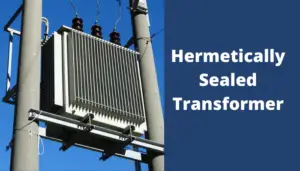Transformers play a critical role in the distribution of electrical power, as they are responsible for transforming the high-voltage electricity from the power plants into low-voltage electricity that can be used by consumers.
However, a transformer can experience a phenomenon called overloading, which can have detrimental effects on the transformer’s performance, efficiency, and even cause damage or failure.
In this article, we will discuss what overloading of a transformer is, its causes, symptoms, consequences, and prevention.
Table of Contents
Understanding Overloading of a Transformer
Overloading occurs when a transformer is forced to carry more current than its rated capacity.
The rated capacity of a transformer is determined by the manufacturer and represents the maximum current that the transformer can carry safely without overheating or causing damage.
When the current flowing through the transformer exceeds this rated capacity, the transformer becomes overloaded.
Let’s take an example to illustrate transformer overloading:
Suppose you have a transformer with a rated capacity of 100 kVA, and it is currently carrying a load of 90 kVA.
The transformer is operating within its rated capacity and is functioning properly. However, due to an increase in load demand, the electrical load on the transformer suddenly increases to 110 kVA.
This surge in current causes the transformer to become overloaded, as it is now carrying more current than its rated capacity.
Overload Capacity of Transformers
The amount of overload a transformer can handle safely depends on several factors, such as the transformer’s design, rated capacity, and cooling system.
In general, transformers are designed to handle some degree of overload for short periods of time, but sustained overload can lead to damage or failure.
Transformer manufacturers typically specify the maximum overload capacity of their products, which is usually expressed as a percentage of the transformer’s rated capacity.
For example, a transformer with a rated capacity of 100 kVA might have a maximum overload capacity of 125% or 150%, meaning it can safely handle loads of up to 125 kVA or 150 kVA for short periods of time.The cooling system of a transformer is also a critical factor in determining how much overload it can handle safely. Transformer cooling systems can be classified into two types: liquid-immersed and dry-type.
Liquid-immersed transformers Overload Capacity
Liquid-immersed transformers are cooled by circulating oil or coolant around the winding and core.
These transformers typically have higher overload capacities than dry-type transformers, as the oil or coolant provides better heat dissipation.
For example, a liquid-immersed transformer might have a maximum overload capacity of 150% or 200%.
Dry-type Transformers Overload Capacity
Dry-type transformers are designed to handle short-term overload conditions without being damaged.
According to ANSI standards, low voltage dry-type distribution transformers can operate at 200% of their nameplate load for up to 30 minutes, 150% load for up to 1 hour, and 125% load for up to 4 hours, as long as a constant 50% load precedes and follows the overload.
These limitations are intended to prevent the transformer’s winding temperature from exceeding safe levels, which could cause damage to the insulation and winding.
However, it’s important to note that continuous overload capacity is not deliberately designed into dry-type transformers. The primary design objective is to ensure that the transformer operates within safe temperature limits under nameplate loading conditions.
Sustained overload can cause the transformer’s temperature to rise to unsafe levels, leading to insulation failure, winding damage, and other problems.
It’s important to note that even with a good cooling system, sustained overload can cause damage to a transformer over time.
To ensure safe and reliable operation, transformers should be operated within their rated capacity as much as possible, and overload conditions should be avoided or minimized whenever possible.
Overloading Causes
- An increase in load demand: When the electrical load on the transformer increases beyond its rated capacity, it can cause the transformer to become overloaded.
- A fault in the electrical system: A fault such as a short circuit or earth fault in the electrical system can cause a sudden surge in current, leading to overloading of the transformer.
- Voltage fluctuations: Fluctuations in voltage can cause an increase in current flow through the transformer, which can lead to overloading.
Symptoms of Overloading of a Transformer
There are several signs that indicate a transformer may be overloaded, including:
- Increased noise: Overloading can cause the transformer to produce more noise than usual due to the magnetic flux becoming unbalanced.
- High temperature: When a transformer is overloaded, it generates more heat than it can dissipate, leading to a rise in temperature. and it starts to operate at a reduced efficiency level. The increased heat generated by the transformer can damage its insulation and winding, potentially leading to a failure or even a fire.
- Reduced voltage output: Overloading can cause a drop in voltage output, which can affect the performance of the electrical system. Let’s dive into details,
When a transformer is overloaded, its winding temperature rises due to the increased current flow.
As the winding temperature rises, the resistance of the winding increases, which can cause a drop in voltage output. This is known as “voltage drop,” and it can cause a variety of problems in the electrical system.
Want to learn more? Click here to explore my in-depth article about Causes and Solution of Voltage Drop.
Consequences of Overloading of a Transformer
Overloading can have serious consequences, including:
- Reduced lifespan: Overloading can reduce the lifespan of a transformer by causing damage to its insulation, winding, and other components.
- Reduced efficiency: Overloading can reduce the efficiency of a transformer, leading to an increase in energy consumption and higher electricity bills.
- Safety hazards: Overloading can cause the transformer to overheat, which can lead to a fire or an explosion.
Preventing Overloading of a Transformer
To prevent overloading of a transformer, the following measures can be taken:
- Proper sizing: Transformers should be sized appropriately for the electrical load they are expected to carry.
- Regular maintenance: Regular maintenance can help detect any faults or issues that may cause overloading. For more information about Transformer Maintenance Read my article here.
- Voltage regulation: Maintaining stable voltage levels can prevent overloading caused by voltage fluctuations.
- Protection devices: Installing protection devices such as circuit breakers and fuses can help prevent overloading due to short circuits or earth faults.
Conclusion
Overloading of a transformer can have serious consequences and should be avoided at all costs.
Understanding the causes, symptoms, and prevention methods can help ensure the safe and efficient operation of transformers in electrical power systems.



